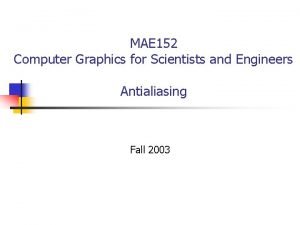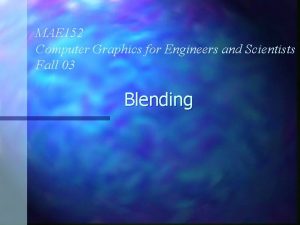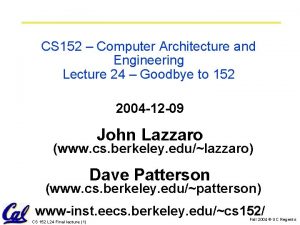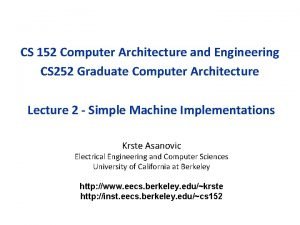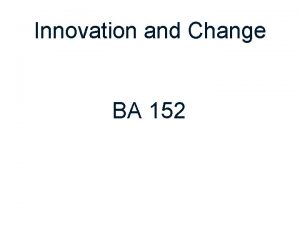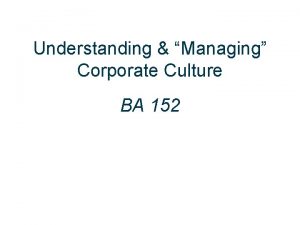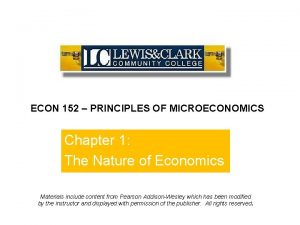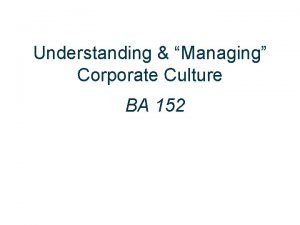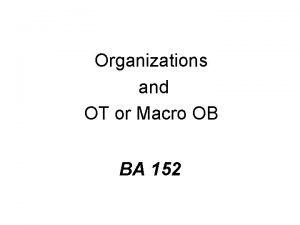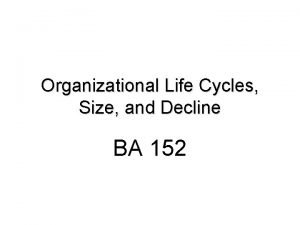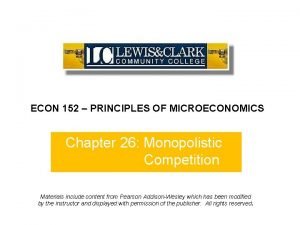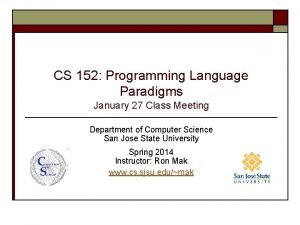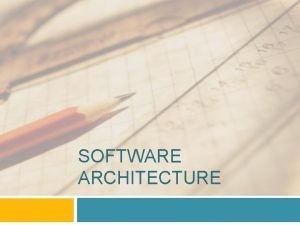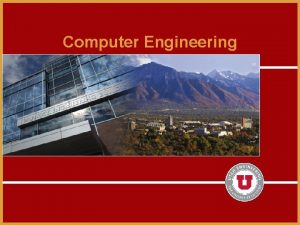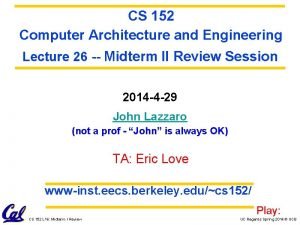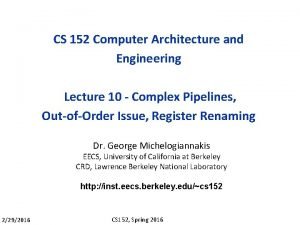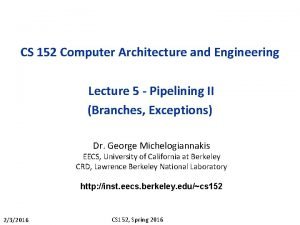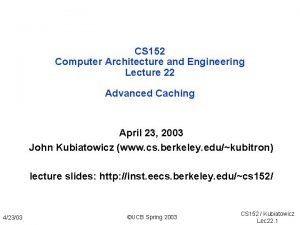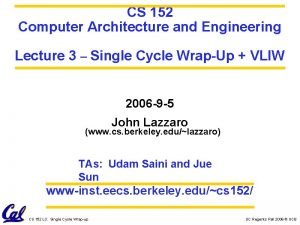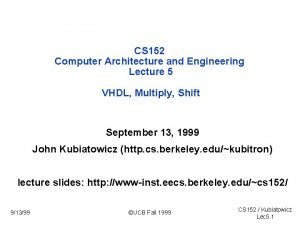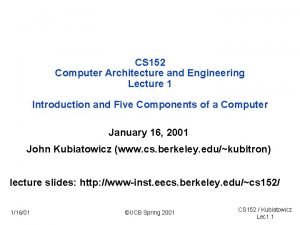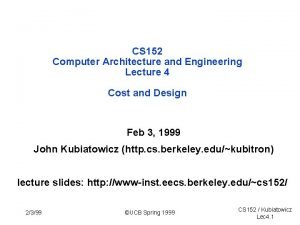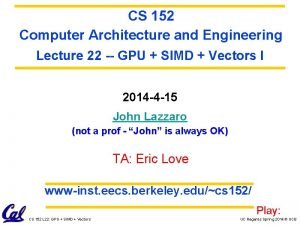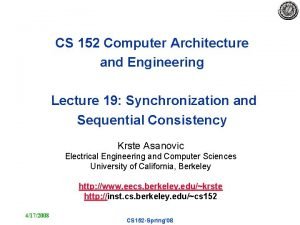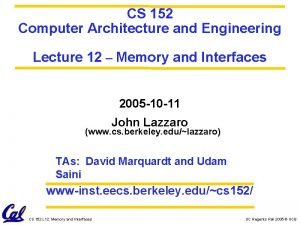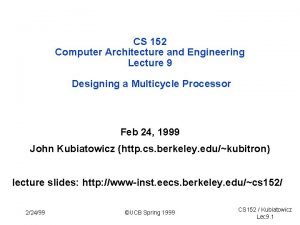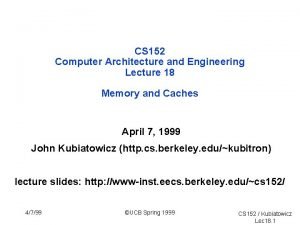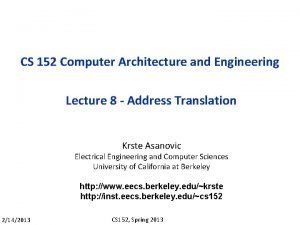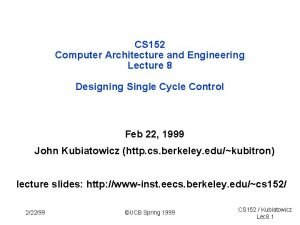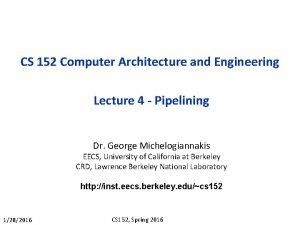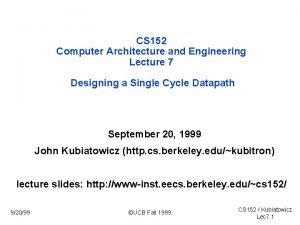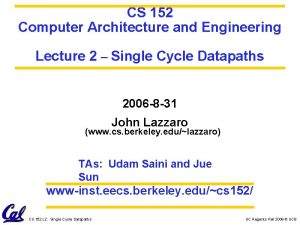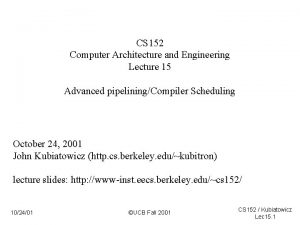CS 152 Computer Architecture and Engineering Lecture 19








































- Slides: 40

CS 152 Computer Architecture and Engineering Lecture 19 – Advanced Processors III 2006 -11 -2 John Lazzaro (www. cs. berkeley. edu/~lazzaro) TAs: Udam Saini and Jue Sun www-inst. eecs. berkeley. edu/~cs 152/ CS 152 L 19: Advanced Processors III UC Regents Fall 2006 © UCB

Last Time: Dynamic Scheduling Fetch up to 8 instructions per cycle. Up to 200 instructions “in flight”. Dispatch up to 5 instructions per cycle Execute up to 8 instructions per cycle A thread may commit 240 physical up to 5 instructions registers per cycle. (120 int + 120 FP) CS 152 L 18: Advanced Processors II UC Regents Fall 2006 © UCB

Today: Throughput and multiple threads Goal: Use multiple instruction streams to improve (1) throughput of machines that run many programs (2) multi-threaded program execution time. Example: Sun Niagara (32 instruction streams on a chip). Difficulties: Gaining full advantage requires rewriting applications, OS, libraries. Ultimate limiter: Amdahl’s law (application dependent). Memory system performance. CS 152 L 19: Advanced Processors III UC Regents Fall 2006 © UCB

Throughput Computing Multithreading: Interleave instructions from separate threads on the same hardware. Seen by OS as several CPUs. Multi-core: Integrating several processors that (partially) share a memory system on the same chip CS 152 L 19: Advanced Processors III UC Regents Fall 2006 © UCB

Multi-Threading (Static Pipelines) CS 152 L 19: Advanced Processors III UC Regents Fall 2006 © UCB

Recall: Bypass network prevents stalls Instead of bypass: Interleave threads on the pipeline to prevent stalls. . . ID (Decode) IR EX IR WB MEM IR IR WE, Mem. To. Reg Mux, Logic From WB A Y R M M B CS 152 L 19: Advanced Processors III UC Regents Fall 2006 © UCB

Introduced in 1964 by Seymour Cray 4 CPUs, each run at 1/4 clock Many variants. . . CS 152 L 19: Advanced Processors III UC Regents Fall 2006 © UCB

Multi-Threading (Dynamic Scheduling) CS 152 L 19: Advanced Processors III UC Regents Fall 2006 © UCB

Power 4 (predates Power 5 shown Tuesday) Single-threaded predecessor to Power 5. 8 execution units in out-of-order engine, each may issue an instruction each cycle. CS 152 L 19: Advanced Processors III UC Regents Fall 2006 © UCB

For most apps, most execution units lie idle Observation: Most hardware in an out-of-order CPU concerns physical registers. Could several instruction threads share this hardware? CS 152 L 19: Advanced Processors III For an 8 -way superscalar. From: Tullsen, Eggers, and Levy, “Simultaneous Multithreading: Maximizing Onchip Parallelism, ISCA 1995. UC Regents Fall 2006 © UCB

Simultaneous Multi-threading. . . One thread, 8 units Cycle M M FX FX FP FP BR CC Two threads, 8 units Cycle M M FX FX FP FP BR CC 1 2 3 4 5 6 7 8 9 M = Load/Store, FX = Fixed Point, FP = Floating Point, BR = Branch, CC = Condition Codes CS 152 L 19: Advanced Processors III UC Regents Fall 2006 © UCB

Power 4 Power 5 2 fetch (PC), 2 initial decodes CS 152 L 19: Advanced Processors III 2 commits (architected register sets UC Regents Fall 2006 © UCB

Power 5 data flow. . . Why only 2 threads? With 4, one of the shared resources (physical registers, cache, memory bandwidth) would be prone to bottleneck. CS 152 L 19: Advanced Processors III UC Regents Fall 2006 © UCB

Power 5 thread performance. . . Relative priority of each thread controllable in hardware. For balanced operation, both threads run slower than if they “owned” the machine. CS 152 L 19: Advanced Processors III UC Regents Fall 2006 © UCB

This Friday: Memory System Checkoff IM Bus IC Bus T e s t V e c t o r s Instruction Cache Run your test vector suite on the Calinx board, display results on LEDs DM Bus DC Bus Data Cache CS 152 L 14: Cache II D R A M C o n t r o l l e r DR AM UC Regents Fall 2006 © UCB

Multi-Core CS 152 L 19: Advanced Processors III UC Regents Fall 2006 © UCB

Recall: Superscalar utilization by a thread For an 8 -way superscalar. CS 152 L 19: Advanced Processors III Observation: In many cases, the on-chip cache and DRAM I/O bandwidth is also underutilized by one CPU. So, let 2 cores share them. UC Regents Fall 2006 © UCB

Most of Power 5 die is shared hardware Shared Components Core #1 L 2 Cache L 3 Cache Control Core #2 CS 152 L 19: Advanced Processors III DRAM Controller UC Regents Fall 2006 © UCB

Core-to-core interactions stay on chip (1) Threads on two cores that use shared libraries conserve L 2 memory. CS 152 L 19: Advanced Processors III (2) Threads on two cores share memory via L 2 cache operations. Much faster than 2 CPUs on 2 chips. UC Regents Fall 2006 © UCB

Coming in 2007: 4 cores per die. . . Current products from Intel and AMD use 2 CPU cores. Both are planning 4 -core designs. CS 152 L 19: Advanced Processors III UC Regents Fall 2006 © UCB

Sun Niagara CS 152 L 19: Advanced Processors III UC Regents Fall 2006 © UCB

The case for Sun’s Niagara. . . For an 8 -way superscalar. CS 152 L 19: Advanced Processors III Observation: Some apps struggle to reach a CPI == 1. For throughput on these apps, a large number of single-issue cores is better than a few superscalars. UC Regents Fall 2006 © UCB

Niagara: 32 threads on one chip 8 cores: Single-issue, 1. 2 GHz 6 -stage pipeline 4 -way multi-threaded Fast crypto support Shared resources: 3 MB on-chip cache 4 DDR 2 interfaces 32 G DRAM, 20 Gb/s 1 shared FP unit GB Ethernet ports Die size: 340 mm² in 90 nm. Power: 50 -60 W Sources: Hot Chips, via EE Times, Infoworld. J Schwartz weblog (Sun COO) UC Regents Fall 2006 © UCB CS 152 L 19: Advanced Processors III

The board that booted Niagara first-silicon Source: J Schwartz weblog (then Sun COO, now CEO) CS 152 L 19: Advanced Processors III UC Regents Fall 2006 © UCB

Used in Sun Fire T 2000: “Coolthreads” Claim: server uses 1/3 the power of competing serv Web server benchmarks used to position the T 2000 in the market. CS 152 L 19: Advanced Processors III UC Regents Fall 2006 © UCB

Project Blackbox A data center in a 20 -ft shipping container. Servers, air-conditioners, power distribution. CS 152 L 19: Advanced Processors III UC Regents Fall 2006 © UCB

Just hook up network, power, and water. . . CS 152 L 19: Advanced Processors III UC Regents Fall 2006 © UCB

CS 152 L 19: Advanced Processors III UC Regents Fall 2006 © UCB

Holds 250 T 1000 servers. 2000 CPU cores, 8000 threads. CS 152 L 19: Advanced Processors III UC Regents Fall 2006 © UCB

CS 152 L 19: Advanced Processors III UC Regents Fall 2006 © UCB

Cell: The PS 3 chip CS 152 L 19: Advanced Processors III UC Regents Fall 2006 © UCB

L 2 Cache 512 KB Power. PC Synergistic Processing Units (SPUs) Power. PC manages the 8 SPUs, also runs serial code. 2 X area of Pentium 4 -- 4 GHz+ cycle time CS 152 L 19: Advanced Processors III UC Regents Fall 2006 © UCB

CS 152 L 19: Advanced Processors III UC Regents Fall 2006 © UCB

Synergistic Processing Units (SPUs) 8 cores using local memory, not traditional caches CS 152 L 19: Advanced Processors III UC Regents Fall 2006 © UCB

One Synergistic Processing Unit (SPU) Programmers manage caching explicitly 256 KB Local Store and 128 -bit Registers SPU issues 2 inst/cycle (in order) to 7 execution units SPU fills Local Store using DMA to DRAM and network CS 152 L 19: Advanced Processors III UC Regents Fall 2006 © UCB

CS 152 L 19: Advanced Processors III UC Regents Fall 2006 © UCB

L 2 Cache Power. PC CS 152 L 19: Advanced Processors III UC Regents Fall 2006 © UCB

Example: Using Cell to Decode HDTV CS 152 L 19: Advanced Processors III UC Regents Fall 2006 © UCB

CS 152 L 19: Advanced Processors III UC Regents Fall 2006 © UCB

Conclusions: Throughput processing Simultaneous Multithreading: Instructions streams can share an out-of-order engine economically. Multi-core: Once instruction-level parallelism run dry, thread-level parallelism is a good use of die area. CS 152 L 19: Advanced Processors III UC Regents Fall 2006 © UCB
 Computer architecture lecture notes
Computer architecture lecture notes Isa computer architecture
Isa computer architecture 01:640:244 lecture notes - lecture 15: plat, idah, farad
01:640:244 lecture notes - lecture 15: plat, idah, farad Diff between computer organization and architecture
Diff between computer organization and architecture Buses in computer architecture
Buses in computer architecture System procurement process in software engineering
System procurement process in software engineering What is basic computer organization
What is basic computer organization Un r 152
Un r 152 Ntuser.dat forensics
Ntuser.dat forensics Przedszkole 152 łódź
Przedszkole 152 łódź![Re liveri [2006] qca 152 Re liveri [2006] qca 152](data:image/svg+xml,%3Csvg%20xmlns=%22http://www.w3.org/2000/svg%22%20viewBox=%220%200%20200%20200%22%3E%3C/svg%3E) Re liveri [2006] qca 152
Re liveri [2006] qca 152 346 rounded to the nearest hundred
346 rounded to the nearest hundred Mae 152
Mae 152 Blending function in computer graphics
Blending function in computer graphics Cs 152 stanford
Cs 152 stanford Cs 152 berkeley
Cs 152 berkeley Ba 152
Ba 152 Ece 152
Ece 152 Ba 152
Ba 152 Lorne priemaza
Lorne priemaza Which layer of the osi model includes vlans
Which layer of the osi model includes vlans Ba 152
Ba 152 Ba 152
Ba 152 Organizational atrophy
Organizational atrophy Hasil dari 202-152 adalah
Hasil dari 202-152 adalah Econ 152
Econ 152 Sjsu cs 152
Sjsu cs 152 Gfi 152
Gfi 152 Money-time relationship and equivalence
Money-time relationship and equivalence Requirement analysis in software engineering notes
Requirement analysis in software engineering notes Foundation engineering lecture notes
Foundation engineering lecture notes Descriptive ethics
Descriptive ethics Computer security 161 cryptocurrency lecture
Computer security 161 cryptocurrency lecture Computer aided drug design lecture notes
Computer aided drug design lecture notes Data centered architecture
Data centered architecture Roman architecture and engineering
Roman architecture and engineering Call and return architecture in software engineering
Call and return architecture in software engineering Forward engineering and reverse engineering
Forward engineering and reverse engineering Computer organization and architecture 10th solution
Computer organization and architecture 10th solution Virtual lab computer organization
Virtual lab computer organization Introduction to computer organization and architecture
Introduction to computer organization and architecture







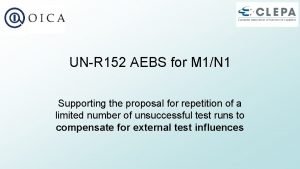
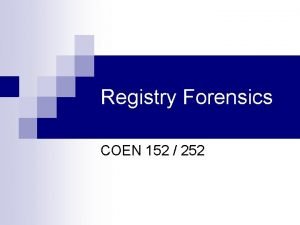

![Re liveri [2006] qca 152 Re liveri [2006] qca 152](https://slidetodoc.com/wp-content/uploads/2020/10/1024173_0ab07c7fa5fe15bbad1bb1a43f32eeb0-300x225.jpg)

